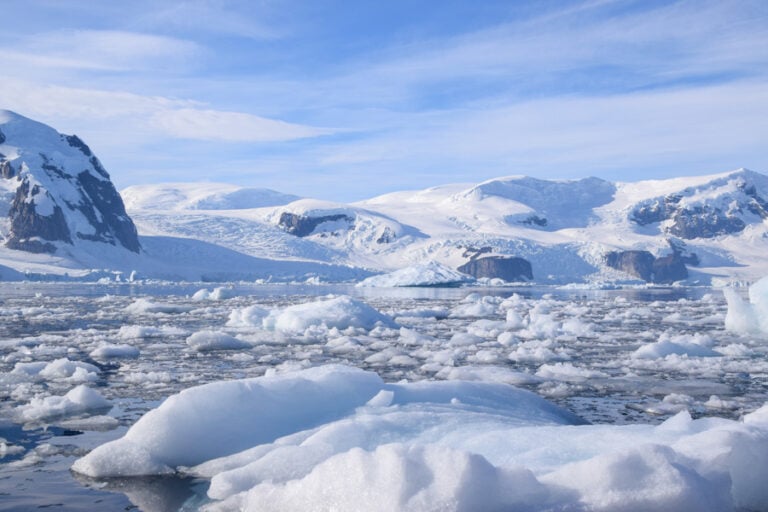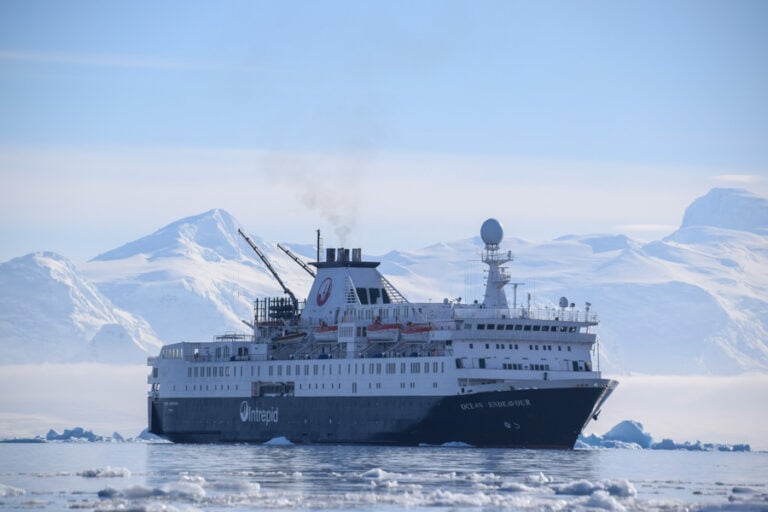The Ultimate Packing List for Antarctica (+ What to Wear)

Are you heading to Antarctica? Yay! It’s one of the most beautiful and surreal places on earth. My two-week Antarctic expedition remains one of my favourite memories ever! There is nowhere else like it on Earth, and it’s fair to say it will be a life-changing experience.
However, deciding what to pack can be a bit of a headache. With cold temperatures and extreme weather, it’s important to have the right gear. However, you don’t need to invest in the latest expensive outdoor wear or pack several cases filled with things you don’t need.
In this post, I’ve shared a detailed Antarctica cruise packing list. This includes exactly what I would pack if I returned to the continent. I’ve also shared some packing tips and what to wear.
If you haven’t booked your cruise yet, check out my post on whether visiting the Antarctic Circle is worth it.
What to wear in Antarctica
Before we get into the ins and outs of packing for Antarctica, let’s cover what to wear. Firstly, you’ll likely have two different needs: clothes for being on the cruise and clothes for the landings/zodiac cruises.
In terms of being on the ship, most Antarctica cruises tend to be very casual. The majority of people on my cruise wore jeans or joggers with a sweatshirt or hoody. It rarely got more fancy than that (although some people did dress up occasionally). Your tour operator should let you know if there are any requirements for what to wear on board.
Getting off the boat and exploring can be more complicated. Wet weather, cold weather, warm weather, sunny weather, windy weather, extreme weather—Antarctica has it all (and in a single day), so you need to pack for all eventualities.
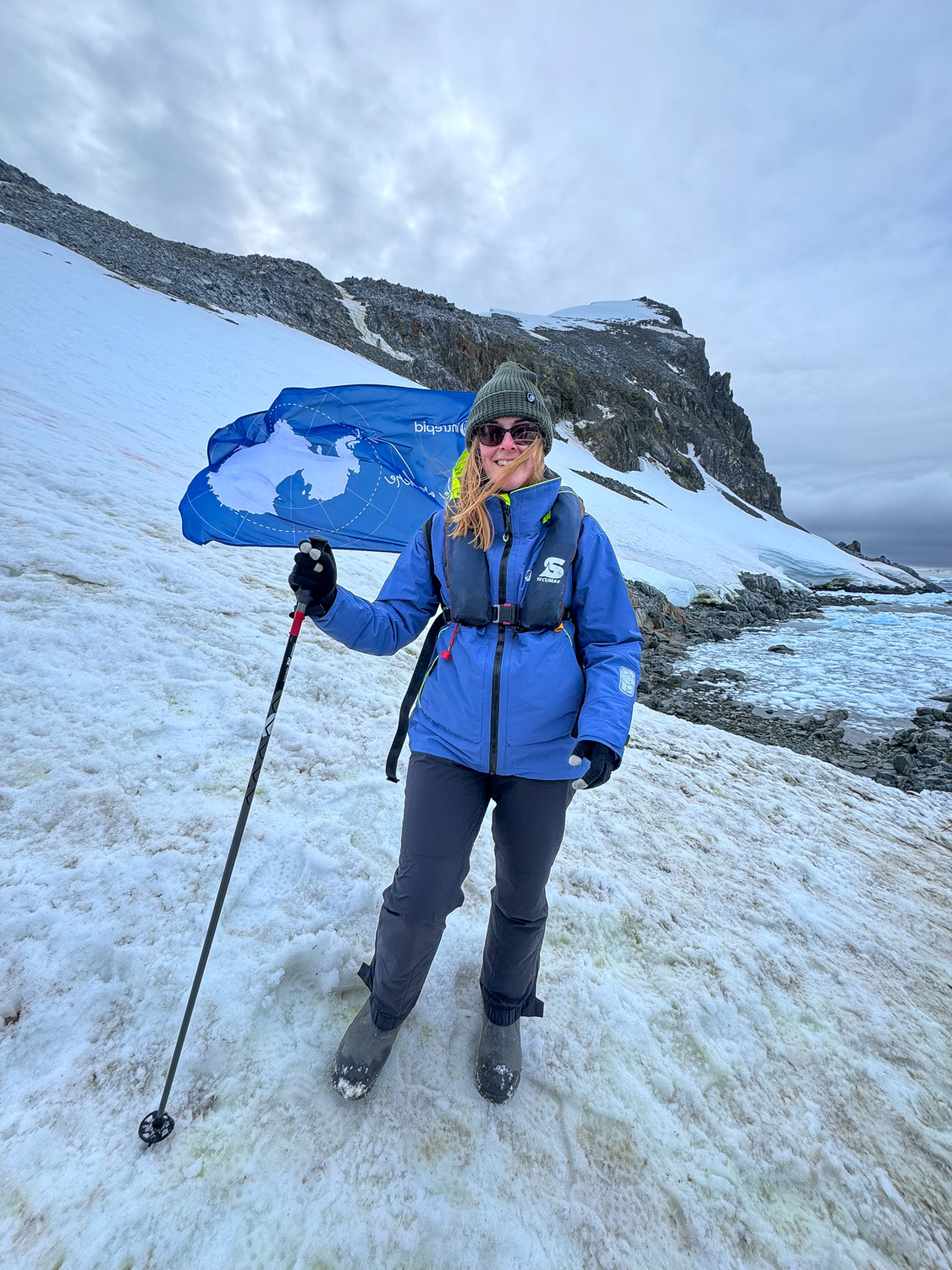
The obvious answer is to pack good quality warm clothes, but they don’t need to be expensive or too technical.
A typical expedition for me involved wearing:
- A long-sleeved base layer when it was cold or a regular sports top for warmer days
- A thin fleece
- A thicker fleece (for colder days)
- A down coat
- A waterproof expedition coat provided by the ship
- Leggings
- Waterproof trousers
Sometimes this was perfect; sometimes I was too hot, and sometimes I was too cold. It’s tough to get it right as it entirely depends on the activities you’ll be doing. The Zodiac boat (RIB boat) rides can be freezing, but when you get to land and start a steep hike, it can get hot quickly.
This is why packing thin layers is the best plan. This way, you can easily add and remove layers as you need to.
Regarding purchasing new equipment, I don’t think you need to invest in anything overly expensive. Sure, having some decent thermal layers might be helpful, but you can find these at a fair and affordable price at places like Mountain Warehouse and Uniqlo. If you don’t want to purchase anything new, you can layer sweatshirts and fleeces to help keep you warm.
I’ve spoken more about exactly what to pack for Antarctica in the list below.

Essential packing items
Waterproof trousers
Starting this Antarctica packing list with an important one – waterproof trousers. Expedition cruise teams usually won’t let you off the boat unless you’re wearing waterproof trousers. If you get wet, you’ll get cold, which could be dangerous in Antarctica. Waterproof trousers help to keep your lower body dry and protect you from the cold.
Some cruise operators may provide a pair of waterproof pants or trousers, meaning you won’t need to take your own. So, it’s well worth checking this in advance. My expedition team was very strict about wearing waterproof trousers. If you weren’t wearing them, you weren’t allowed to get off the boat.
If you need to take your own, I wouldn’t recommend investing in anything expensive. My waterproof trousers got destroyed in Antarctica. On a typical landing, there would be thousands of penguins which means lots of penguin poo. This then needed to be cleaned using bleach. My trousers were completely ruined by the end.
Ultimately, all you need is something to keep the worst of the water off. The trousers must also be wide enough to go over your boots to help prevent water from going inside your footwear.

Base layers
The weather can vary in Antarctica, and overall, it wasn’t as cold as I had expected. However, you must still be prepared and pack some warmer base layers.
Personally, I found the Zodiac boat rides to be the coldest. We sometimes drove through the wind and rain/snow for up to two hours, and it’s fair to say it got absolutely freezing.
I’d suggest packing at least one thermal base layer. Merino wool base layers are always a great idea, but you don’t need to invest in anything overly expensive. On the colder days, I wore a long-sleeved thermal top from Uniqlo (which sells a range of affordable thermal clothes), and it did the job perfectly.
You could also consider packing some thermal tights to help keep your legs warm. I had some in my backpack but didn’t end up using them. My leggings and waterproof trousers were enough to keep me warm.
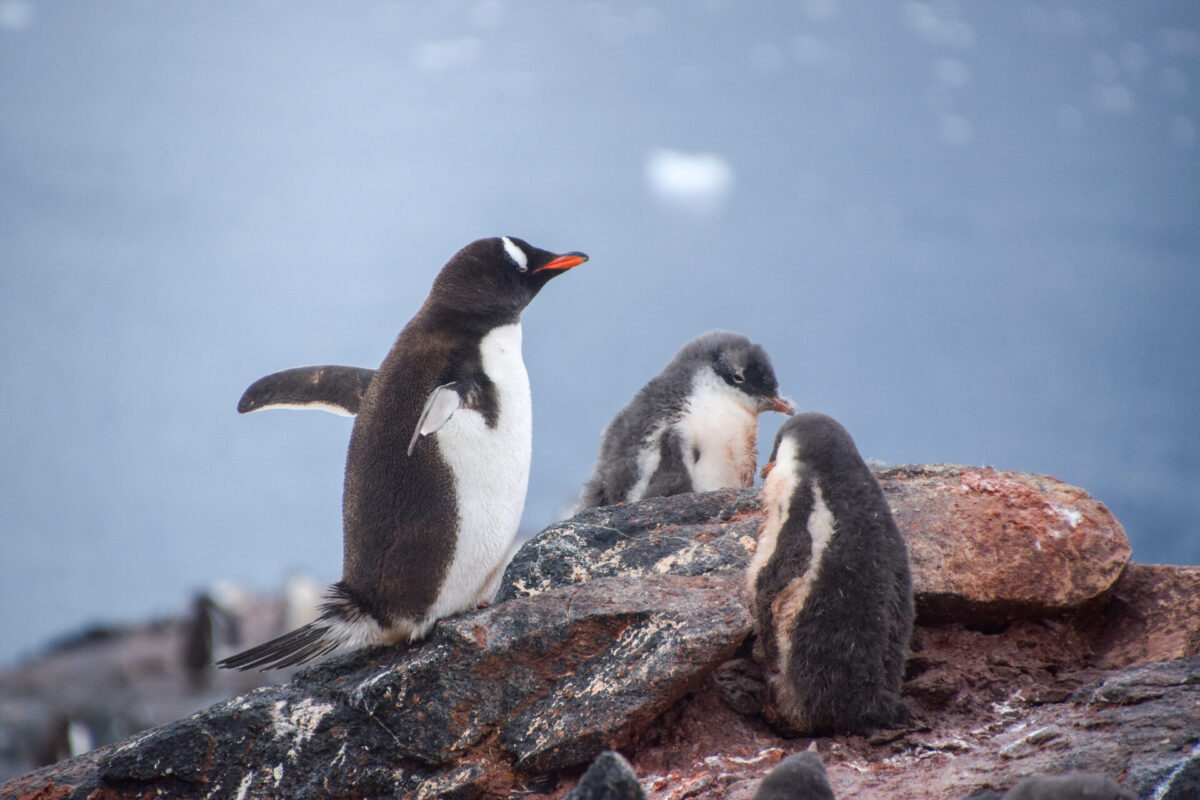
Warm fleeces or sweatshirts
Once you’ve sorted the base layers, you’ll need the warmer top layers. I suggest packing at least two or three fleeces to help keep you warm.
I packed two thinner fleeces (which were very warm) and one thick fleece. This meant I could layer depending on the weather and what I would do that day. Remember, there is often the option to do some steep hikes, and you can get warm very quickly.
You also don’t want to wear so much that you can’t move, which happened to me several times. This is generally okay for the boat rides, but it won’t be comfortable once you’re on land.

Activewear
I’d suggest packing some activewear for the land expeditions. I normally wore a pair of leggings or hiking trousers, a sports bra, and a sports T-shirt (plus all my thermals).
Of course, this is entirely individual, but I don’t think you’ll enjoy exploring Antarctica in jeans and a fancy top! (For what it’s worth, our expedition team explicitly told us not to wear jeans.) A few people wore snow pants/trousers or simple cargo pants.
Some of the hikes can also get a bit sweaty, and most activewear helps to regulate your body temperature.
Warm coat
Even with all the layers, you will want a warm coat. Down jackets are the best option as they tend to be warm without being too bulky. In most cases, the tour operator provides everyone with a down coat and a waterproof and windproof jacket at the start of the expedition. However, it’s important to check this in advance.
Although we were given a lovely Kathmandu down jacket, I’m still happy that I packed my own. The coat they provided wasn’t always warm enough, and there’s no guarantee it will fit. You’ll also likely need a coat for Ushuaia, so it’s sensible to pack your own.
Intrepid also gave us a large waterproof jacket which we had to wear on any of the shore landings (no exceptions). Sometimes, this was sufficient to keep me warm (along with my base layers and fleeces), but other times, I was glad to have my down coat as well.

Other clothes for the boat
You’ll be spending a lot of time on the ship, so it’s important to have comfortable and casual clothes. In most cases, you’ll spend two days getting to Antarctica and two days returning to Ushuaia, plus there are evenings on board.
I spent most of my time on the board in jeans and a hoody or sweatshirt. Some people stayed in activewear, and some went a bit more formal. It really depends on what you’re comfortable wearing.
I’d suggest packing the following for onboard the boat:
- T-shirts (I’d pack at least five or six, but this will depend on how long your cruise is)
- At least one pair of jeans
- Alternative trousers
- Two or three sweatshirts/knitwear
- A smarter top or dress if you feel it’s required
More often than not, the expedition companies will tell you if there is a dress code. I’ve spoken more about formal wear in the section below.

Suitable shoes
Deciding what shoes to take seems to always be a dilemma when packing for Antarctica. Thankfully, it doesn’t have to be that complicated.
Nearly all tour operators will provide you with rubber boots or waterproof boots (also known as muck boots), and you won’t be allowed off the ship unless you’re wearing these. This means you don’t need to worry about packing something suitable for land excursions (as always, check this with your tour operator just in case they need you to bring your own).
So, you only need to worry about what to wear on the boat itself. Our ship had a “no open-toe” policy for footwear, meaning you weren’t allowed to wear flip-flops or sandals when moving around the boat. I spent most of my time in trainers/sneakers but also saw people wearing slippers in the evenings.

Simply put, I would bring a pair of trainers to wear on board, and perhaps some flip-flops for your room or in case your boat has a sauna or spa. If you have the space, you could also consider slippers. If you’re planning formal evenings, you may also want to pack for that.
Side note: If you’re spending time in Ushuaia beforehand, consider packing hiking boots as there are some great treks there.
Hat and waterproof gloves
Remember to pack a warm hat and waterproof gloves. Wearing a warm hat helps to stop body heat escaping from your head, keeping you much warmer overall. I recommend a warm and woolly hat for the best effect.
It’s also a good idea to pack waterproof gloves (something I failed to do). Your gloves can get very wet on the Zodiac boat, and your hands will freeze once wet. Waterproof gloves will not only keep your hands warm but also dry. Trust me, I speak from experience. You could also consider packing some hand warmers for those colder Zodiac cruises.
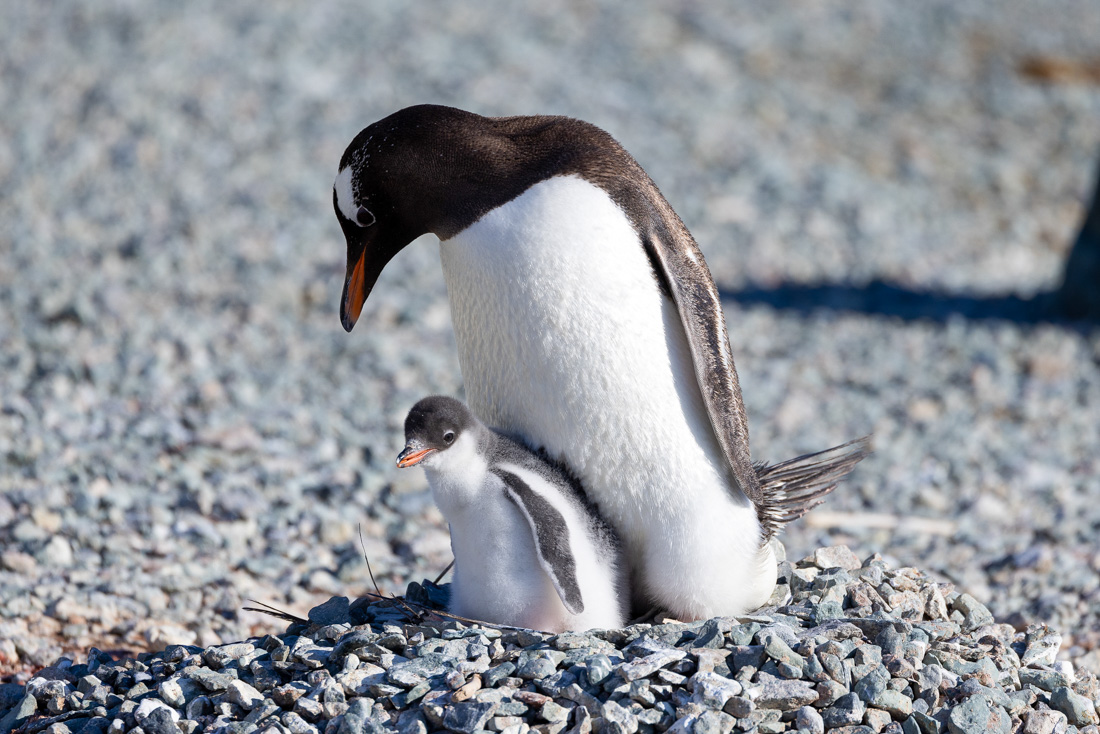
Neck gaiter
The one item I forgot when visiting Antarctica was a neck gaiter (or buff), and wow, did I regret it! Those Zodiac rides can be absolutely freezing, and you feel it the most on your face.
The buff can be used to cover your mouth and neck, and it helps to keep your face warm.
Suncream and sunglasses
One thing I wasn’t expecting in Antarctica is that the sun would be incredibly strong. Along with strong UV rays, the sun is reflected off the ice, snow and water which can quickly lead to sunburn. Make sure you pack a strong SPF for your face.
You’ll also need a good pair of sunglasses. Even in the cloud, I struggled to see anything without sunglasses. The sun can be so strong, and when it reflects off the ice, it can really hurt your eyes.
I’d suggest testing a couple of pairs in advance to ensure they’re strong enough.
Side note: I even saw some people wearing ski goggles; it was THAT bright, especially on sunny days.

Dry bag
Once in the Antarctic Peninsula, you’ll likely take a Zodiac boat to reach land or a cruise to spot marine life. While the idea is to stay as dry as possible, rain and sea water can easily splash inside and get valuables wet.
If you want to keep items like your phone and camera dry, you may benefit from packing a dry bag/waterproof bag. These bags are designed to keep anything valuable dry. You could also consider keeping a ZipLock bag inside a bigger bag.
If you plan to do any activities such as kayaking, you should be provided with a waterproof bag (but I’d pack one just in case).
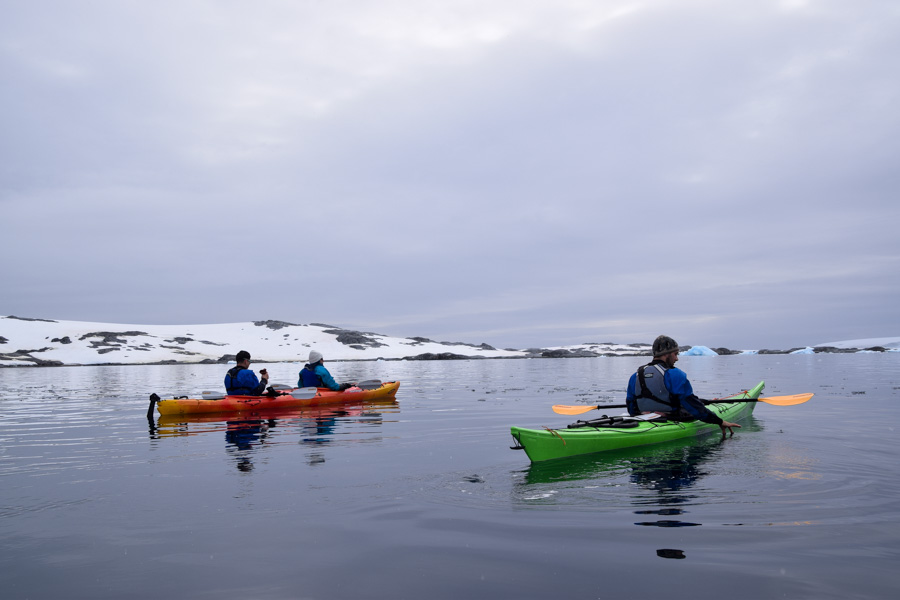
Plug adaptors
You’ll no doubt want to charge your phone or camera at some point while you’re on the cruise, so make sure to pack the correct adapter.
I always travel with my trusty global adapter, which works with all plugs worldwide. My ship (the Ocean Endeavour) had UK type-G plugs, but it can vary depending on the boat. You can check with your tour operator in advance or buy a global adaptor.
Remember, you’ll also need an adaptor for your time in Argentina, and the plugs may not be the same as on the boat.
Warm socks
While the rubber boots will help to keep your feet warm, you’ll want some warm socks. I often had to wear two pairs to keep my feet toasty (although my feet are always cold).
Wool socks are an excellent option because they not only help to keep your toes warm, but also keep moisture at bay.
I’d recommend packing enough pairs to get you through your expedition days.

Reusable water bottle
Most cruises to Antarctica aim to be as sustainable as possible by limiting the use of plastic. Our boat had no plastic bottles. If you wanted water, you’d need to use a glass or fill up your reusable bottle.
Some land excursions can last for a few hours, so I recommend packing a reusable water bottle to take to shore. Most boats have stations where you can refill your bottles.
Medicines (including sea sickness medicine)
Antarctica is arguably the most remote region on Earth. Once on the peninsula, you’re a two-day boat ride from shops or signs of civilisation. This means there’s no pharmacy you can visit if you need some medication, especially prescription medication.
With this in mind, remember to pack anything you might need. Our boat did have a doctor, but they were not there to freely hand out any medications you may have forgotten.
The only medication she was happy to hand out was for seasickness. However, it’s a sensible idea to take your own with you. The two days crossing the Drake Passage can be extremely rough, and you don’t want to suffer.
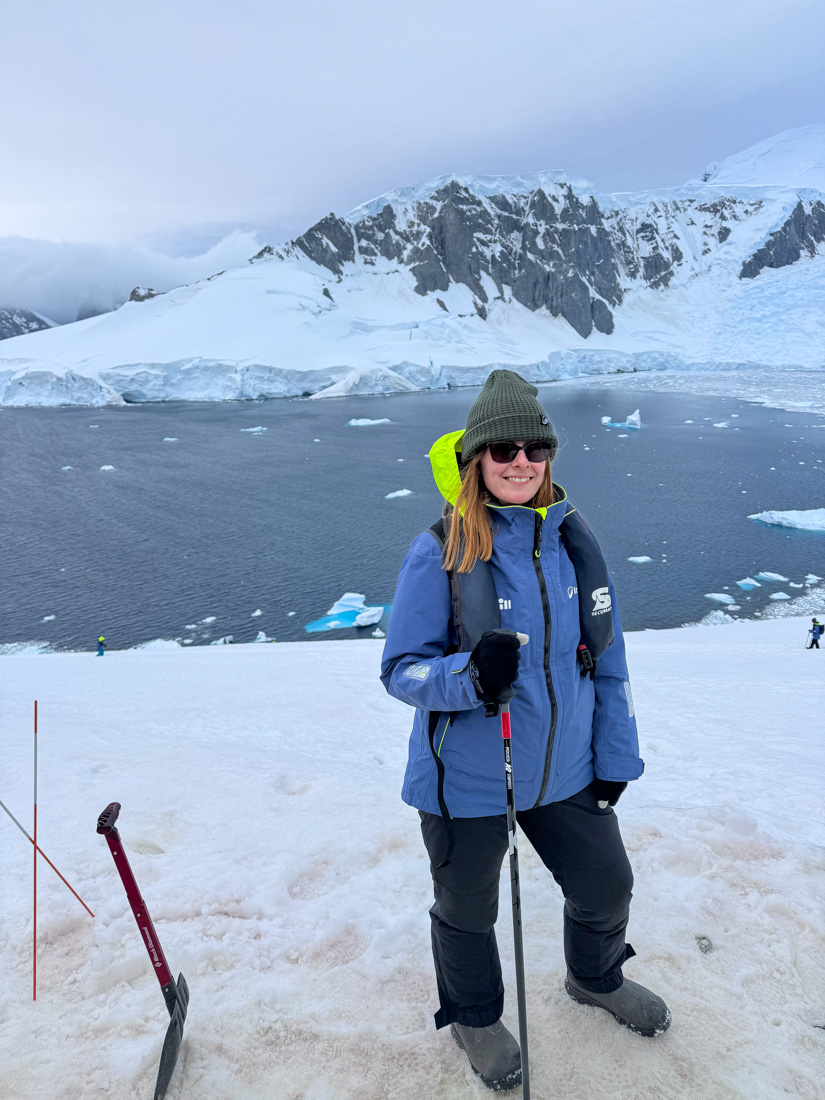
Other essentials
I’ve left a few obvious essentials off this list, but don’t forget to pack the basics:
- Underwear
- PJs
- Toiletries
- Makeup (if you need it)
- Bras
- Lip balm (my lips got SOOO dry in Antarctica)
Other items to consider
Swimwear
Swimming isn’t probably the first thing that comes to mind when planning a trip to Antarctica, but most cruises offer you the chance to do the famous Polar Plunge. If you dare, you can jump into the freezing waters of Antarctica! Despite the water’s temperature, you’ll do this in your regular swimwear (you only stay in for a few seconds).
Some ships also have a hot tub, swimming pool, or sauna, so you may find some swimwear useful for this too.
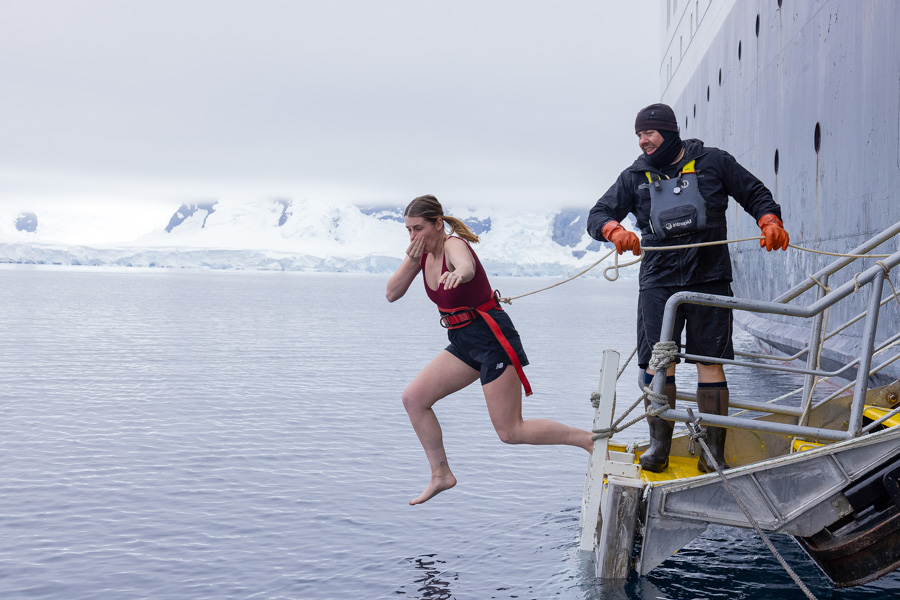
Formal wear
One of the questions about cruises to Antarctica that seems to come up the most is, ‘Do I need to take formal wear?’. If you’ve been on a cruise before, you’ve more than likely had to have some smart clothes for the evening or for a ‘formal night’. So what’s it like in Antarctica?
I’ll preface this by saying that every ship and tour operator differs. However, in my experience, Antarctica tends to be very casual. Most ships carry a maximum of 100 people, and there’s usually only one buffet-style restaurant (at least most of the time). So, wearing jeans or joggers is absolutely acceptable.
My boat was very casual, but a few people occasionally wore smarter clothes, such as dresses and shirts. However, it was never anything overly formal. I lived in a hoody and never once felt under-dressed.
If you opt for a more luxurious cruise, you may need (or want) to take something smarter for the evenings. Most tour operators will let you know in advance if they require you to wear any formal wear.
However, for the most part, cruises to Antarctica tend to be laid-back and casual.
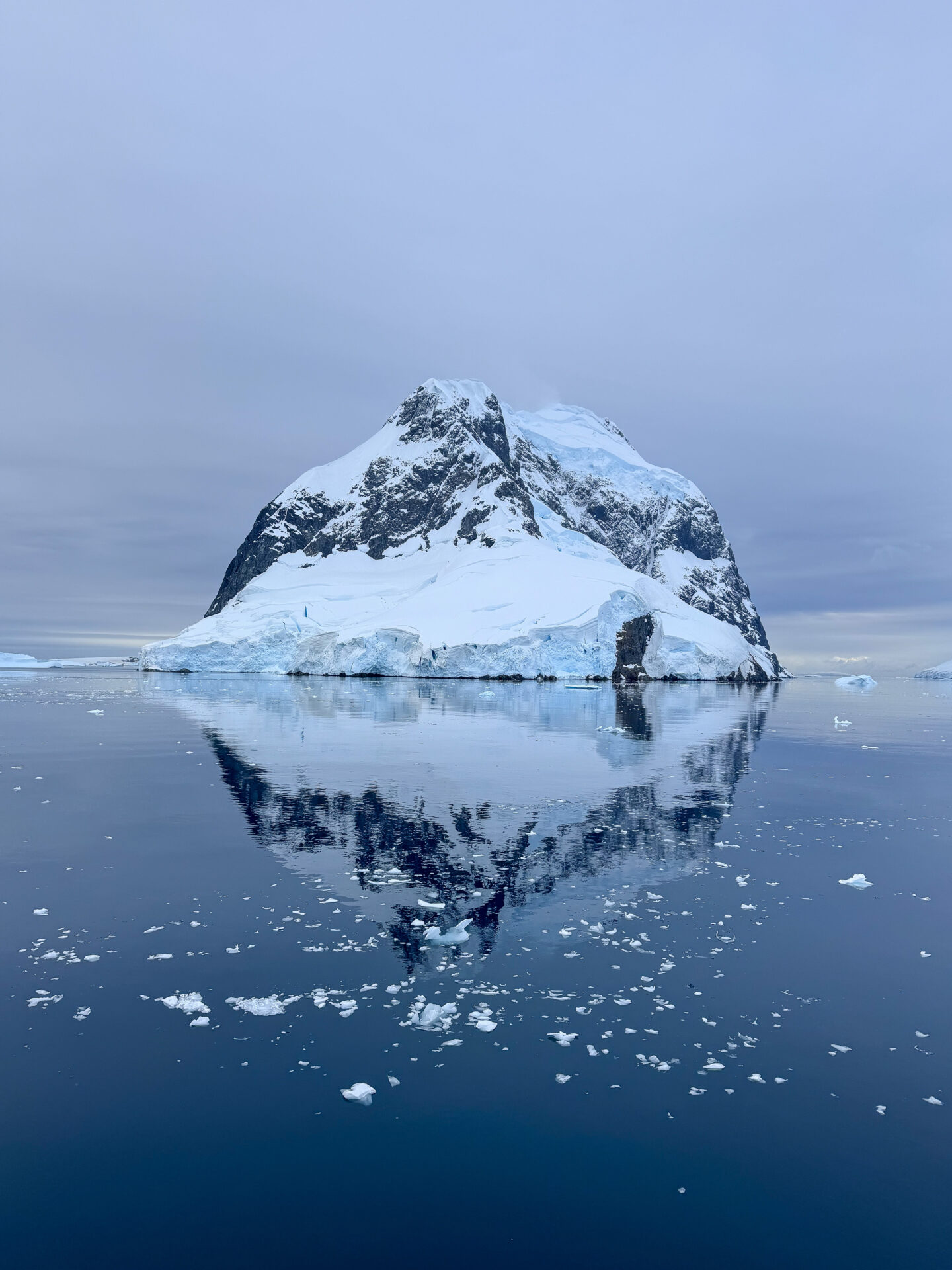
Waterproof coat
A waterproof coat normally comes under an essential packing item, but most tour operators provide a mandatory one you must wear on any excursion.
Our expedition team would not let us off the boat unless we wore the bright blue waterproof coat they provided. This was to ensure that they could easily identify us if we wandered off or got lost and that we were fully waterproof.
As I’ve said several times in this post, every tour operator is different. However, wearing a mandatory coat seems to be the case for every tour I’ve seen. Even so, it’s worth checking, just in case you need to take your own.
It’s worth noting that the waterproof coats weren’t to keep at the end (unlike the down coats). You may benefit from having a waterproof jacket for other parts of your trip to Argentina, especially if you’re heading into Patagonia or hiking in El Chalten. The coats are also kept in the mud room, and you might find it easier to have your own to hand for when you go out on deck.
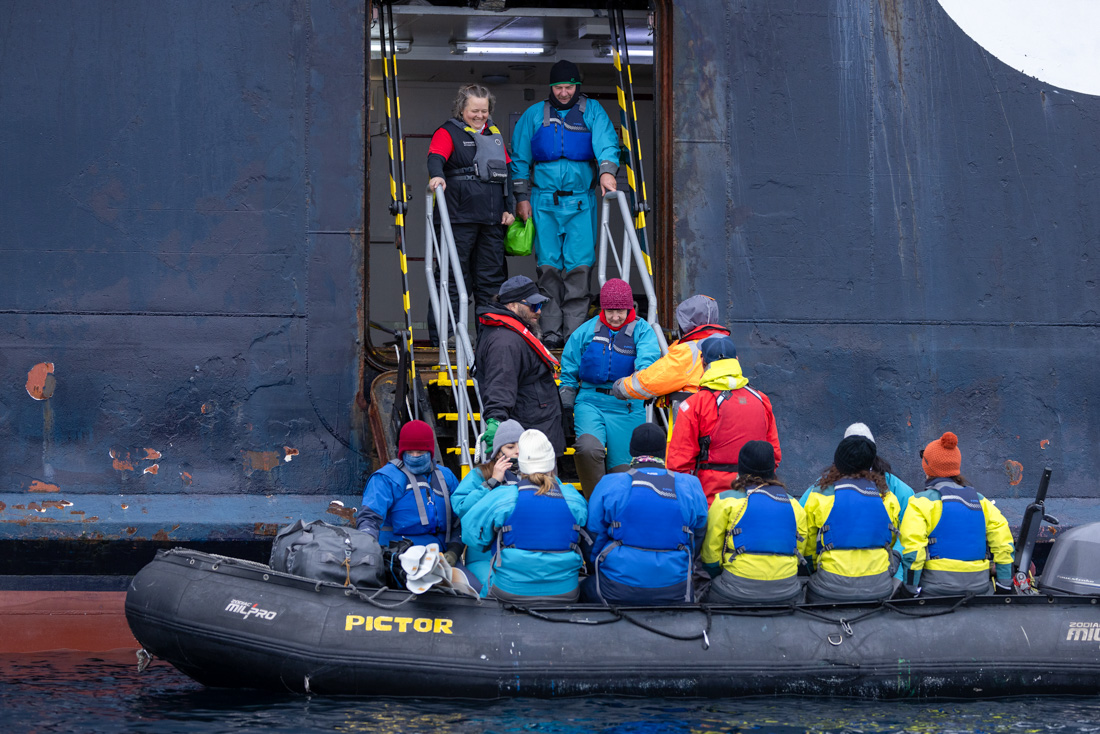
Walking sticks
One of the things I underestimated about my trip to Antarctica was the level of hiking. I expected the landings to be quick and a case of walking around small areas, not hiking up steep and slippery slopes.
If you want to explore as much as possible, you’ll benefit from taking hiking poles. Many of the trails were incredibly slippery from the snow and ice, and having a pole helped me stay on my feet.
Our tour operator (Intrepid) provided sticks, but there weren’t enough for everyone. If you think you’ll need some, I’d take your own. Just be prepared to clean them in between excursions (they don’t mess around when it comes to bio-security).
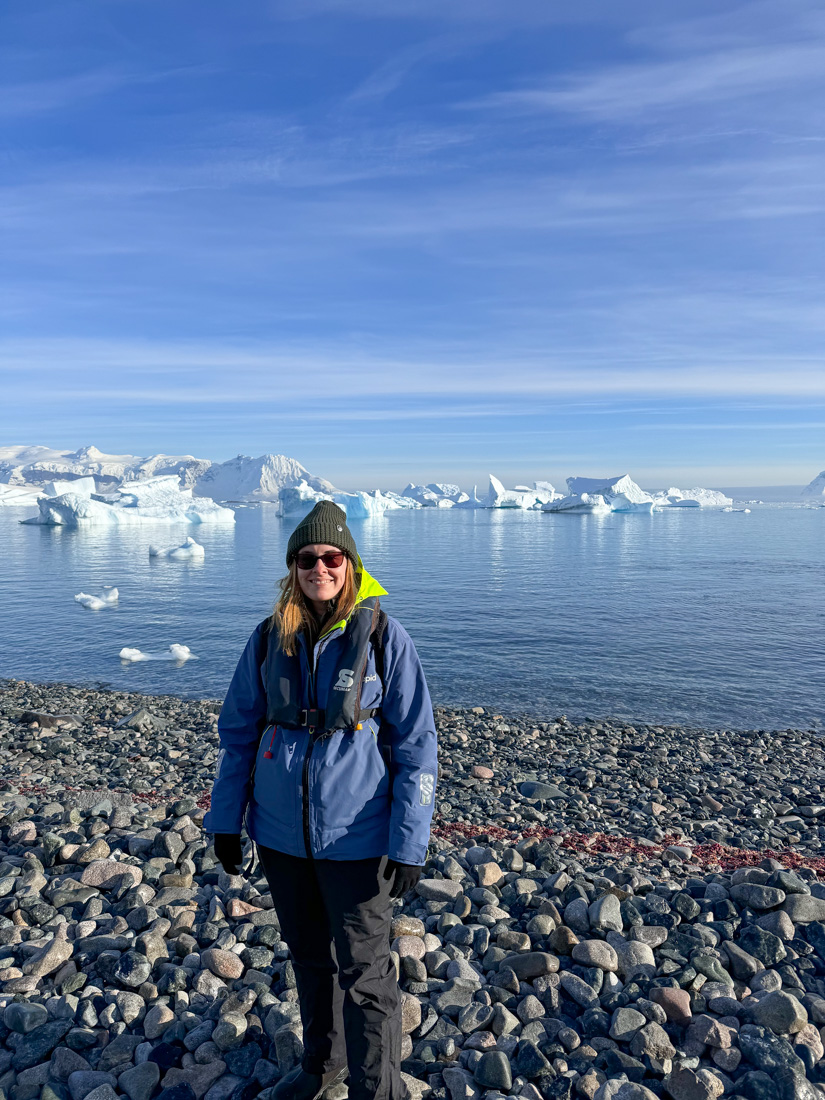
Day bag
Most days on the peninsula will involve a landing or two, which could mean spending several hours off the boat at a time. In all honesty, it really varied. Sometimes, we were off for two hours; other times, it could be up to four hours.
If you want to be able to take anything you might need with you (such as extra suncream, layers, or water), then pack a daypack. I’ve said this before, but I LOVE my packable Rohan bag. It packs away small but can fit loads when it’s opened out.
I certainly found having a day bag useful.
Binoculars
If you’re a keen birdwatcher or want to see wildlife in the distance, consider bringing a pair of binoculars. A lot of the wildlife we saw was quite far away, and there were times I wished I had packed a pair.
Of course, they take up a lot of space and can be heavy, so many people might choose not to pack some. While they add to the experience, I wouldn’t say they’re essential.
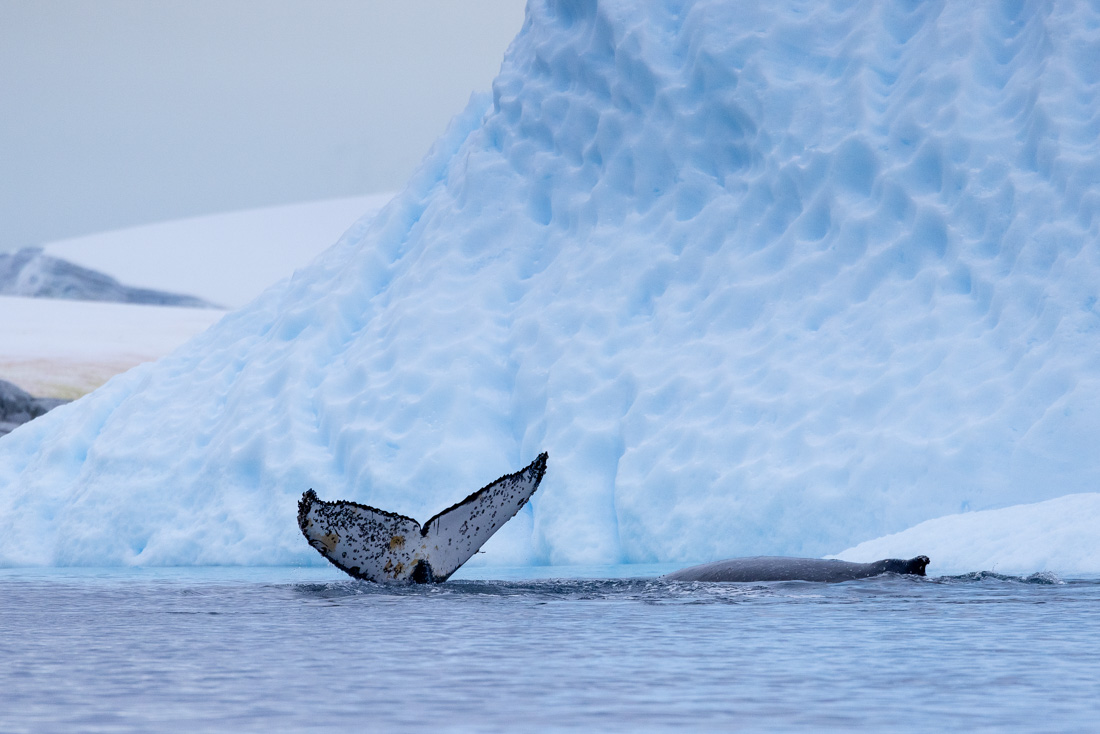
Waterproof phone case
You’ll no doubt want to snap away on your phone camera during your trip. With wildlife and amazing scenery in all directions, it’s hard to keep your phone away.
I took a waterproof phone case with me, and I’m so glad I did. There were several days when the Zodiac boats were very wet, and it would have been hard to have my phone out without damaging it. The clear phone cases allow you to take photos, even when the phone is sealed in the case.
The phone case was also handy for when I went kayaking. I could have my phone out and take photos without worrying about it getting wet.
Camera equipment
With unique wildlife, epic scenery and incredible icebergs, Antarctica is a photographer’s DREAM. Honestly, it’s one of the most beautiful places I’ve ever been. The scenery almost felt fake at times.
I don’t have a fancy camera and generally use my phone or bridge camera, but if you’re into photography, TAKE YOUR CAMERA. I don’t think many other places on Earth are quite as photogenic as Antarctica.
Remember to pack everything you need, including lenses, spare batteries, and spare SD cards (you won’t be able to buy more once you leave Ushuaia).
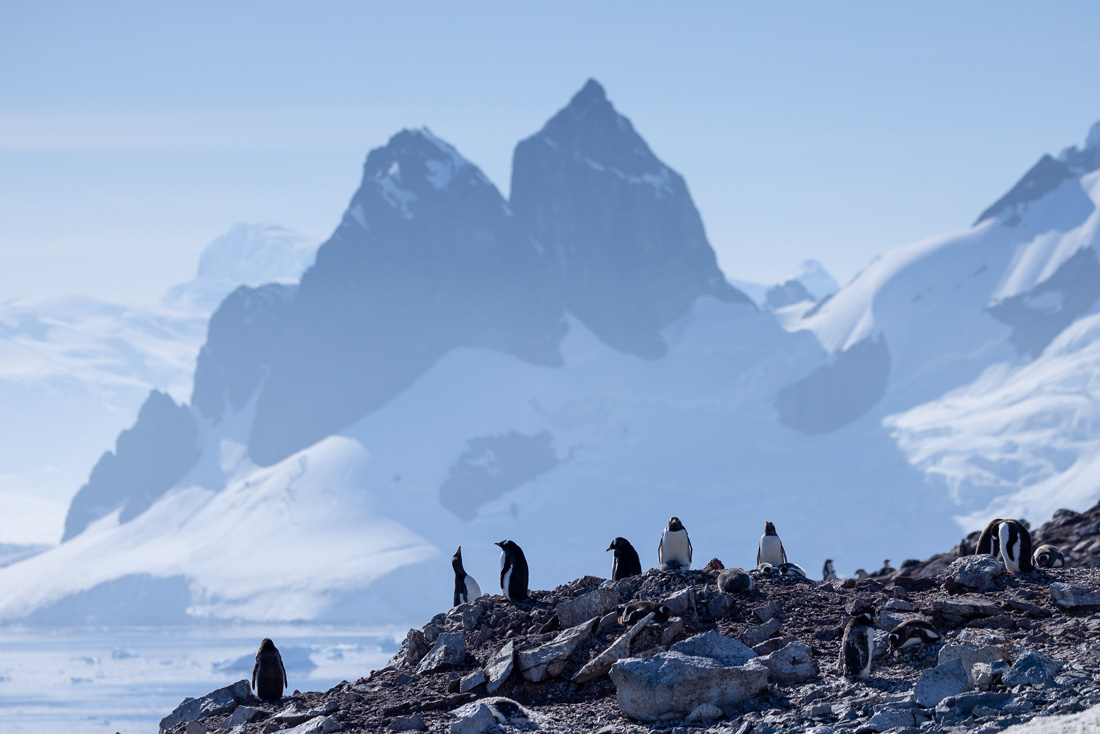
Snacks
Food was abundant on my trip to Antarctica. The day began with a buffet breakfast and after our first expedition of the day, there was a mid-morning snack. This was followed by a huge lunch, and on sea days, we even had afternoon tea.
The evenings started with snacks, followed by a 3-course dinner and then late-evening snacks. Cookies and fruit were always available throughout the day, so you likely won’t need to take any snacks with you.
However, if you have a restricted diet or are a bit picky about what you eat, it might be a sensible idea to take your own.
Entertainment
I was surprised at how busy the days were down on the Peninsula. We usually woke early, had breakfast, and then spent the rest of the morning on land or the Zodiac boats. After lunch, there was usually some time to relax before the afternoon activities.
By the time we had freshened up and listened to our evening briefing, it was time for dinner, the evening lecture (or entertainment), and then bed.
However, the sea days are another story. You spend two days travelling to Antarctica and another two days returning. While our expedition team were great at filling the days with interesting lectures, it’s a good idea to take some form of entertainment with you.
I’d suggest packing a Kindle or iPad so you can read or watch TV shows and movies. Just remember to download everything you want before leaving home, as you won’t be able to access the internet in Antarctica.
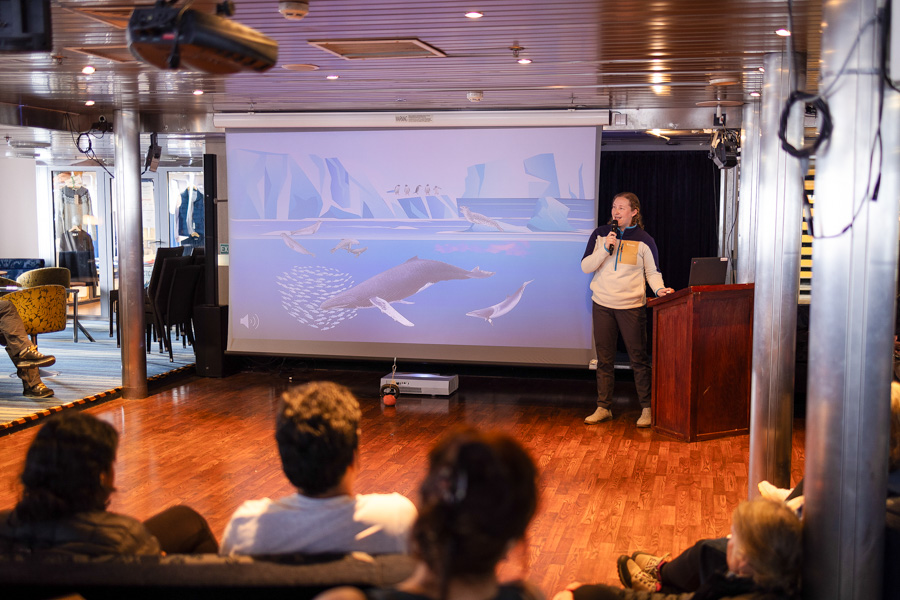
Laundry detergent
The cost of doing laundry on our boat was even more expensive than a regular hotel. If you think you might need to do some laundry, I suggest taking some detergent and perhaps a portable washing line.
I did a bit of washing and could hang it in the bathroom.
Earplugs
Boats can be very noisy, so if you’re a light sleeper, don’t forget to pack earplugs. I personally found the noise quite soothing and consistent, but I know some people struggled.
Travel towel
Most cruises to Antarctica include towels, so you shouldn’t need to pack your own. Ours also included towels for the hot tub and sauna, so we didn’t need to get our bedroom ones wet.
I think it’s unlikely that you’ll need to take your own, but it’s worth checking.

Other packing tips for Antarctica
Check the provided gear
Most tours to Antarctica include basics such as rubber boots and a waterproof coat, but it’s worth checking in advance. I’ve seen some tour operators that give you everything you might need, including a dry bag and trekking poles, and others that offer the bare minimum.
The cruise company should list what they provide on the website.
Confirm luggage restrictions
While the boats don’t tend to have a luggage limit, you might find the flight from Buenos Aires to Ushuaia does. I noticed that Intrepid had a strict 15 KG luggage limit on their website. When I asked them directly, they said this only applied to people who had also booked the flight with them.
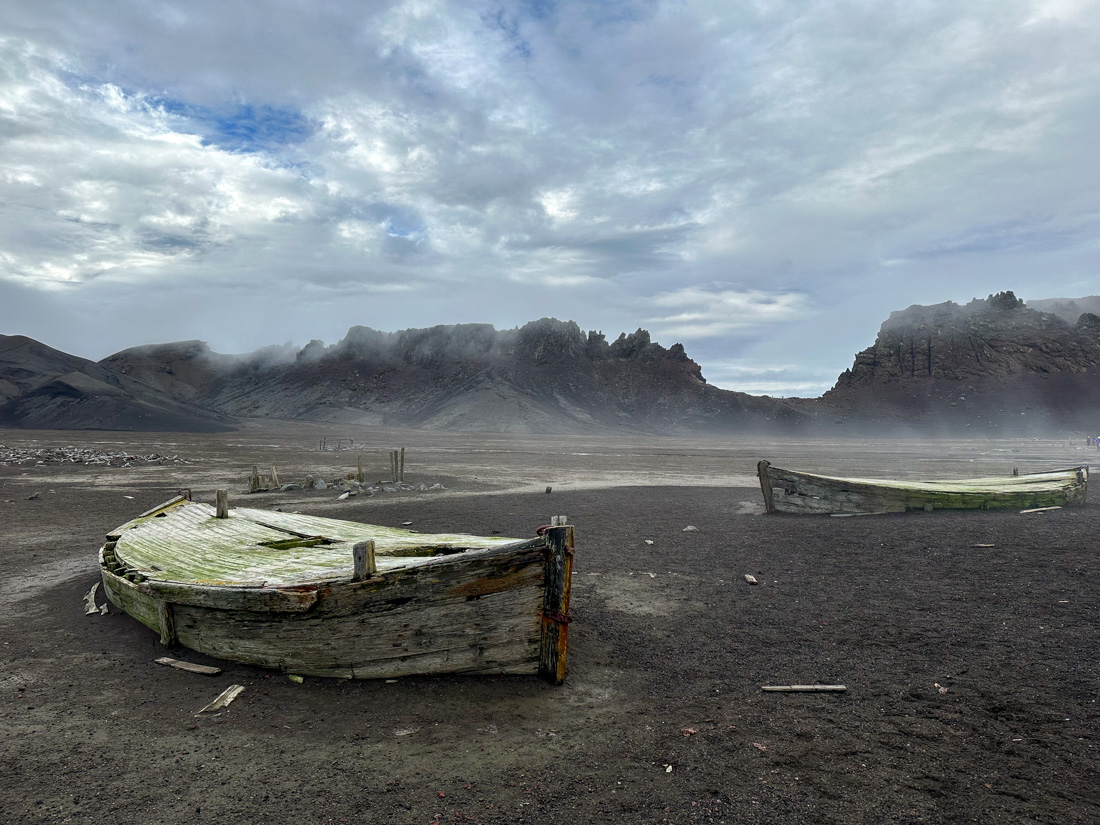
It can be very warm
The weather in Antarctica is unpredictable and extreme. Even in the summer, there can be heavy snow and wind. However, it can also be very warm. On days when the sun was out in full, I found myself sweating underneath all my layers (especially when hiking).
I’d suggest packing lots of lighter layers so you can layer accordingly and easily add/remove.
Use a duffle bag or backpack
Most rooms on the boats are tiny (unless you’ve booked a premium room), so there’s nowhere to keep a big suitcase. If you use a backpack or duffle bag, you can at least shove it somewhere out of the way.
Laundry tends to be expensive
As I mentioned above, don’t rely on doing laundry on the boat. It can be incredibly expensive, so it might be a better idea to pack your own detergent.
I hope you found this packing list for Antarctica helpful and that you have a wonderful time on your Antarctic cruise.

